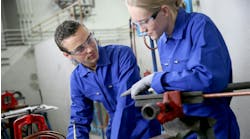Latest from Management
Sponsored
Recently I received a number of questions, like the following one, from readers about sizing indirect water heaters: I am considering an indirect and looking at the Triangle Tube Smart 50 or 40. The boiler I am considering is also Triangle Tube Prestige 110 at 110,000 Btuh. The next size, Prestige, is 160,000 Btuh or more. The Triangle Tube Smart 50 has boiler output Btuh listed at 140,000. The Smart 40 has boiler output listed at 112,000 Btuh. Should the boiler I select be capable of, or close to, the output listed for the indirect?
The Triangle Tube indirect water heater has a very low head-loss, which means the contractor can utilize one of a number of low wattage circulators now available, which saves on parasitic electricity costs. That has the potential to translate into $21.60 saved each year, and can add up to $1,435 given the projected 30-year life-span for a stainless-steel indirect and the historical 5% increase in electrical cost.
There are two basic approaches for adding an indirect to the mix. Ignore its load, and size the boiler to the home's heat loss, or add some or all of its required rating to the heat loss Btus and up-size the boiler.
I prefer to stick with the home's heat loss and ignore the indirect's added load because heating domestic water represents about 5% of a 24-hour cycle and we're only at design conditions about once every 10- to 20-years (as we were this past winter).
Here's how I approach this issue
Take what the manufacturer gives you with a grain of salt. Check and you'll likely find they used 180°F or hotter boiler water coupled with a specified size boiler with 100% of its Btu-rating devoted to the production of domestic hot water. That's the lab-world, not the real-world you and I live in.
The use of modcon boilers, many of which now qualify for the $1,500 federal tax credit, grants the installer the option of setting the boiler's upper water-temperature limit and time-out for the hydronic side, and it's not likely to be 180°F or higher.
Peak efficiency for modcon boilers is achieved by extracting the latent heat energy from the condensate, and that typically limits the outlet temperature to 160°F or lower. This, in turn, results in lowered recovery rates for the indirect and a possible need to increase its size to accommodate the peak hour draw-down.
Start with the peak load demand by asking your customer about their personal habits: length of showers, overlapping hot water use, etc. Ask them to adjust the temperature (or use the assumption of 115°F at the showerhead). Measure the GPM for each point of use, so you know how many gallons will be required during that peak demand time period. Total gallons × 0.85 will give you the quantity of hot water from the tank itself (on average for 120°F storage and 40°F inlet-temperature).
In all likelihood that number will exceed the tank's volume. Next, I calculate the actual recovery rate for the tank and boiler combination I'm using at whatever temperature I'll allow the boiler to use while in domestic production mode. Calculate the GPM recovery rate and multiply that by the expected draw during peak demand to determine total recovery possible and then subtract 10% to 15% for mixing that will take place inside the tank between cold entering water and hot water in storage.
Triangle's ratings are based upon a low of 50°F entering and 200°F from the boiler. Virtually everywhere in the U.S. we will see 40°F entering during the coldest weather and, in my opinion, 200°F is unrealistic for modern modcon boilers and kills efficiency. For domestic hot water production, I set the boiler's outlet temperature at a minimum of 20°F above my domestic water heater's storage temperature.
Typically, that means I'll be installing a larger indirect, so that once its fully recovered and ready for that peak demand, it will allow for my customers to draw-down the added volume to meet peak-load demand. My boiler will simply run longer to recharge the extra volume required to satisfy everyone.
Take the 110°F at 95%, which assumes you'll be in full condensing mode. If you're going to ramp up to 180°F, you will likely fall off to about 87% efficiency. But, just for the sake of argument, we'll stick with 95%, which nets us 104,500 Btus. Water coming in at 40°F and finishing at 120°F needs an 80°F rise and 80 × 8.34 = 667.2 Btus per gallon required. Therefore, 104,500 ÷ 667.2 = 156.625 ÷ 60 = 2.61 GPM recovery. In reality, not all of the hourly net boiler rating will make the transition, but I'd feel safe with an 80% transfer rate for a net of 2 GPM. Triangle Tube is showing an 88% transfer rate at the 200°F boiler output vs. 50°F potable cold-water inlet.
You're starting with 50 gallons of water, and let's say you have three folks wanting to shower in the morning: mom, dad and junior. The two showerheads will deliver 2.5 GPM each. Mom and dad go back-to-back for a combined total of 20 minutes and junior hits the shower for at least 15 minutes. In theory, we can expect them to use a total of 87.5 gallons mixed down with roughly 85% coming from the tank, during design conditions, or roughly 74.5 gallons of hot water in just 20 minutes run-time. We've got 46 gallons in storage, but we'll lose roughly 10% to mixing for a net of 41.5 gallons. We can add back in 2 × 20 for recovery that will yield a total of 81.5 gallons. Looks like we can handle the peak demand load, but there's not much room for error or a change in bathing times, like when junior becomes a teenager!
The best part of this exercise is educating the customer, so if they run out of hot water, they'll know why and self-adjust. Besides you can cover your butt by letting them decide which indirect they want after explaining exactly what each one can yield.
Dave Yates owns F.W. Behler, a contracting company in York, Pa. He can be reached by phone at 717/843-4920 or by e-mail at [email protected].
All Dave Yates material on this website is protected by Copyright 2008. Any reuse of this material (print or electronic) must first have the expressed written permission of Dave Yates. Please contact via email at: [email protected]
Dave Yates
Dave Yates material in print and on Contractor’s Website is protected by Copyright 2017. Any reuse of this material (print or electronic) must first have the expressed written permission of Dave Yates and Contractor magazine.

